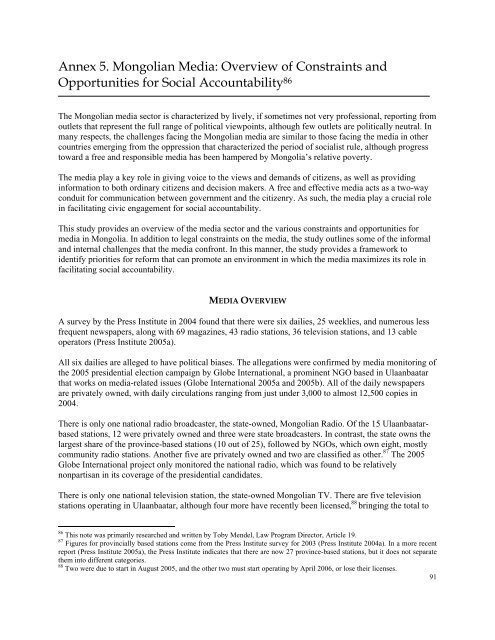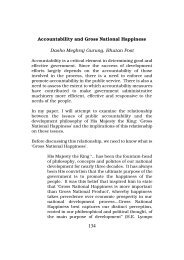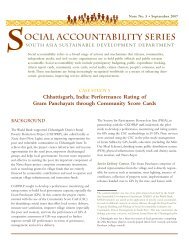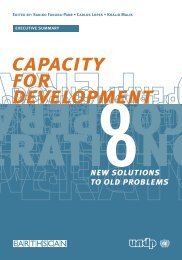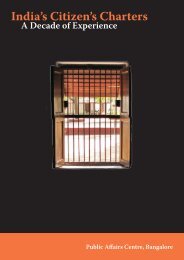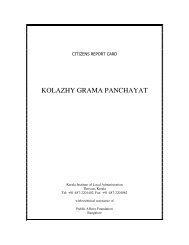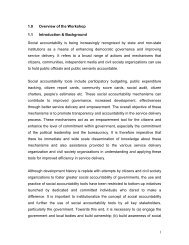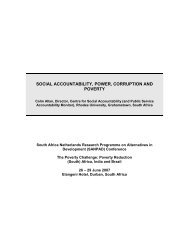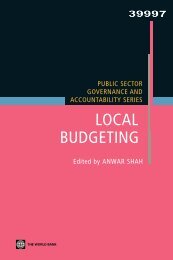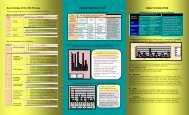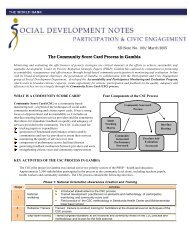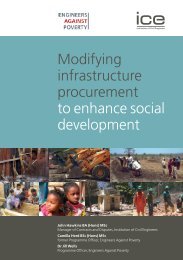Enabling Environment for Social Accountability in ... - SASANet
Enabling Environment for Social Accountability in ... - SASANet
Enabling Environment for Social Accountability in ... - SASANet
Create successful ePaper yourself
Turn your PDF publications into a flip-book with our unique Google optimized e-Paper software.
Annex 5. Mongolian Media: Overview of Constra<strong>in</strong>ts and<br />
Opportunities <strong>for</strong> <strong>Social</strong> <strong>Accountability</strong> 86<br />
The Mongolian media sector is characterized by lively, if sometimes not very professional, report<strong>in</strong>g from<br />
outlets that represent the full range of political viewpo<strong>in</strong>ts, although few outlets are politically neutral. In<br />
many respects, the challenges fac<strong>in</strong>g the Mongolian media are similar to those fac<strong>in</strong>g the media <strong>in</strong> other<br />
countries emerg<strong>in</strong>g from the oppression that characterized the period of socialist rule, although progress<br />
toward a free and responsible media has been hampered by Mongolia’s relative poverty.<br />
The media play a key role <strong>in</strong> giv<strong>in</strong>g voice to the views and demands of citizens, as well as provid<strong>in</strong>g<br />
<strong>in</strong><strong>for</strong>mation to both ord<strong>in</strong>ary citizens and decision makers. A free and effective media acts as a two-way<br />
conduit <strong>for</strong> communication between government and the citizenry. As such, the media play a crucial role<br />
<strong>in</strong> facilitat<strong>in</strong>g civic engagement <strong>for</strong> social accountability.<br />
This study provides an overview of the media sector and the various constra<strong>in</strong>ts and opportunities <strong>for</strong><br />
media <strong>in</strong> Mongolia. In addition to legal constra<strong>in</strong>ts on the media, the study outl<strong>in</strong>es some of the <strong>in</strong><strong>for</strong>mal<br />
and <strong>in</strong>ternal challenges that the media confront. In this manner, the study provides a framework to<br />
identify priorities <strong>for</strong> re<strong>for</strong>m that can promote an environment <strong>in</strong> which the media maximizes its role <strong>in</strong><br />
facilitat<strong>in</strong>g social accountability.<br />
MEDIA OVERVIEW<br />
A survey by the Press Institute <strong>in</strong> 2004 found that there were six dailies, 25 weeklies, and numerous less<br />
frequent newspapers, along with 69 magaz<strong>in</strong>es, 43 radio stations, 36 television stations, and 13 cable<br />
operators (Press Institute 2005a).<br />
All six dailies are alleged to have political biases. The allegations were confirmed by media monitor<strong>in</strong>g of<br />
the 2005 presidential election campaign by Globe International, a prom<strong>in</strong>ent NGO based <strong>in</strong> Ulaanbaatar<br />
that works on media-related issues (Globe International 2005a and 2005b). All of the daily newspapers<br />
are privately owned, with daily circulations rang<strong>in</strong>g from just under 3,000 to almost 12,500 copies <strong>in</strong><br />
2004.<br />
There is only one national radio broadcaster, the state-owned, Mongolian Radio. Of the 15 Ulaanbaatarbased<br />
stations, 12 were privately owned and three were state broadcasters. In contrast, the state owns the<br />
largest share of the prov<strong>in</strong>ce-based stations (10 out of 25), followed by NGOs, which own eight, mostly<br />
community radio stations. Another five are privately owned and two are classified as other. 87 The 2005<br />
Globe International project only monitored the national radio, which was found to be relatively<br />
nonpartisan <strong>in</strong> its coverage of the presidential candidates.<br />
There is only one national television station, the state-owned Mongolian TV. There are five television<br />
stations operat<strong>in</strong>g <strong>in</strong> Ulaanbaatar, although four more have recently been licensed, 88 br<strong>in</strong>g<strong>in</strong>g the total to<br />
86 This note was primarily researched and written by Toby Mendel, Law Program Director, Article 19.<br />
87 Figures <strong>for</strong> prov<strong>in</strong>cially based stations come from the Press Institute survey <strong>for</strong> 2003 (Press Institute 2004a). In a more recent<br />
report (Press Institute 2005a), the Press Institute <strong>in</strong>dicates that there are now 27 prov<strong>in</strong>ce-based stations, but it does not separate<br />
them <strong>in</strong>to different categories.<br />
88 Two were due to start <strong>in</strong> August 2005, and the other two must start operat<strong>in</strong>g by April 2006, or lose their licenses.<br />
91


